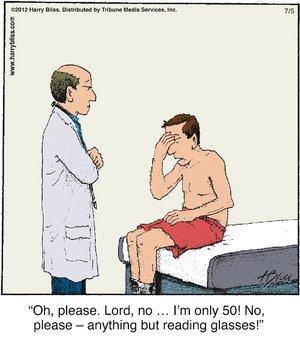Since 1993 I’ve been counseling patients on how to get used to glasses and contact lenses. ‘Just give it some time’ – I’ve said on hundreds of occasions. And fortunately, a little time is all it takes typically. With single vision lenses the transition into a new pair of glasses is usually quick – often minutes – but when a patient is moving into a bifocal (especially a no-line bifocal) the advice is usually to give them a week and if you are still having problems come back for an adjustment.
I’ve been a patient requiring eyewear for longer than I’ve been a doctor. I got my first pair of glasses the day before I turned 16 after I finally admitted to my parents that I was having trouble seeing at a distance. Honestly, the thought of not passing my driver’s license vision screening had been looming large in my mind for months. Since then I’ve had lots of eyeglasses. Really large ones from years ago that my kids laugh at (in my defense, they were stylish at the time) and really small ones. Clear lenses, tinted lenses, Transitions lenses, polarized lenses, and even a pair with safety lenses have filled a variety of frames since that first pair.
I’m a little nearsighted so removing my glasses has given me very good near vision for years. But I’m only a little nearsighted. Those with more substantial amounts of nearsightedness have a distinct advantage when trying to read fine print. I’ve since past the point of removing my glasses to read effortlessly so about a month ago I got something new. That’s right – I got my first pair of no-line bifocals. There, I admitted it. In public. (Gulp.)
So far, the transition has gone pretty well. Like those I’ve coached through this before I noticed immediately that the floor at my feet was blurry. Of course it is – I’m looking at it through my bifocal. Then I noticed my computer screen was a little blurry. Then I tilted my head up just slightly and it instantly was crystal clear. Looking side to side with my eyes made things swim a bit. Check, I’ve warned people about those side effects for years.
Besides the years of experience talking about these I think there are a few other reasons why the transition has gone well. For starters, I didn’t wait until reading became all but impossible. The physics that allows these bifocals to not have a line becomes a bit more challenging to adapt to as the bifocal gets stronger. Starting with a strong bifocal power increases the chances of having problems with adaptation.
Second, I have a well designed lens. My new lenses are produced by Essilor and are called the TruClear HD. This lens is a new offering for our office and I’m happy to say that it appears to be a great lens. It is produced in the Transitions material to darken when I go outside and the Viso XC Plus glare free coating that not only cuts down on reflections but also makes the lens much easier to clean than my previous pair of glasses.
Third, they are well fit. Any pair of glasses is only as good as the measurements taken at the time they are ordered and the adjustment they are given at the time they are dispensed. With no-line bifocals those measurements and fitting are even more critical. Thankfully, our optical staff is great at this and my result is not the exception but the rule.
So next time you are in the office, feel free to check in with me about my progress and commiserate about the joys of seeing your 40th birthday party in the rear view mirror.
– Scott McDougal, O.D.
